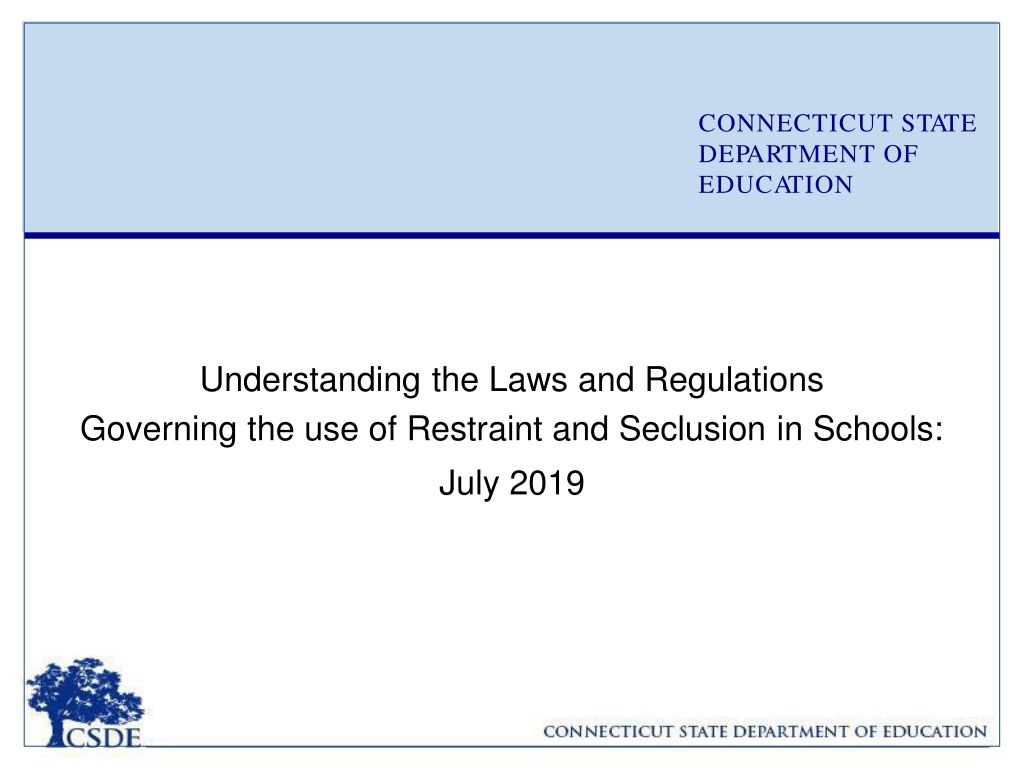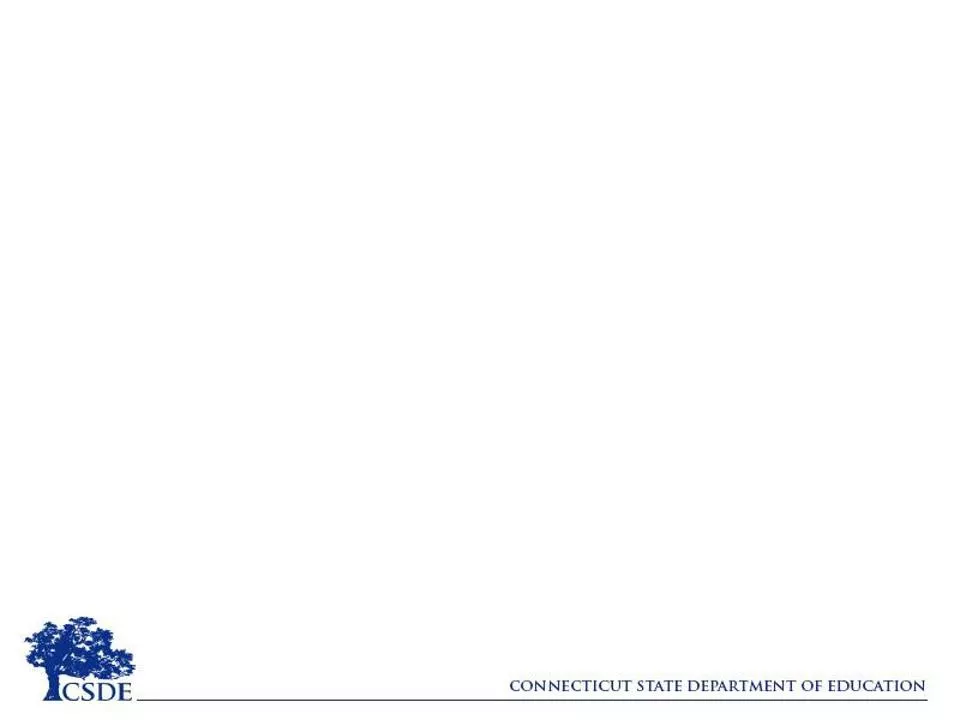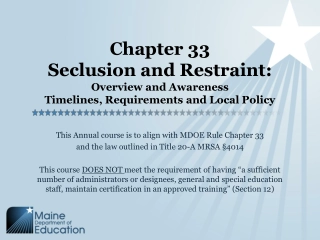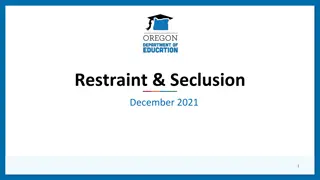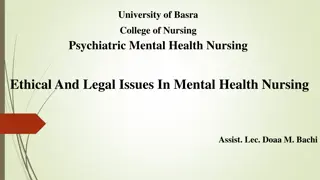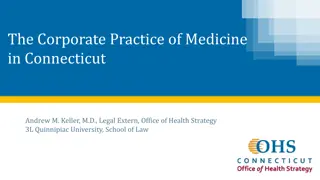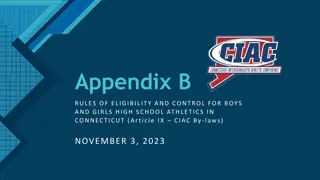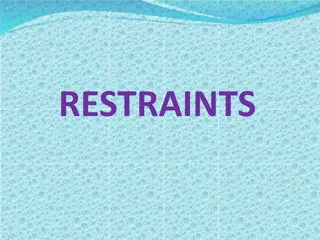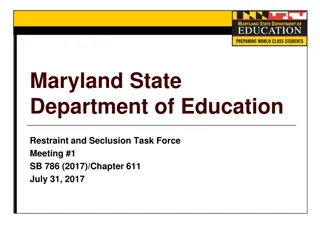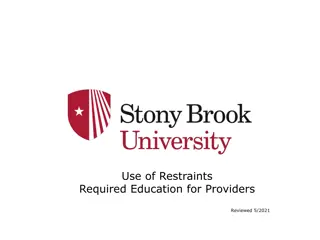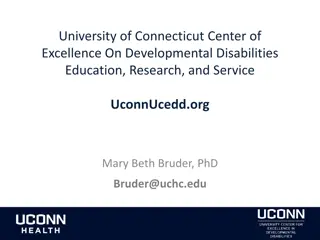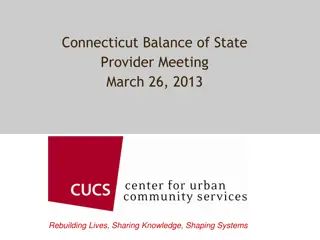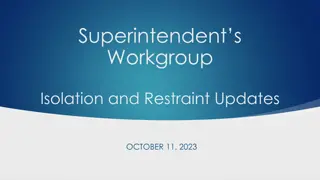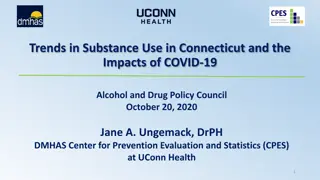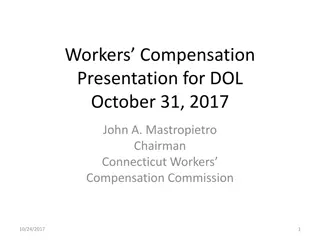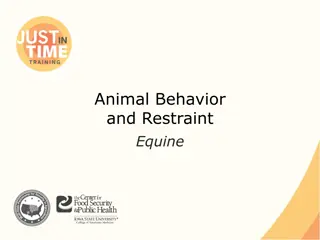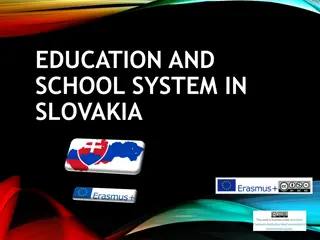Laws and Regulations Governing Restraint and Seclusion in Connecticut Schools
Connecticut State Department of Education's July 2019 guidelines outline Public Act 18-51, which prohibits the use of restraint and seclusion in schools, except in emergency situations. The act maintains prohibitions for all public school students Grades K-12, including those requiring special education services. It revises definitions, clarifies intervention methods, and emphasizes the importance of individualized planning and placement team meetings. Exceptions to the prohibition allow restraint and seclusion in emergencies to prevent injury.
Download Presentation

Please find below an Image/Link to download the presentation.
The content on the website is provided AS IS for your information and personal use only. It may not be sold, licensed, or shared on other websites without obtaining consent from the author. Download presentation by click this link. If you encounter any issues during the download, it is possible that the publisher has removed the file from their server.
E N D
Presentation Transcript
CONNECTICUT STATE DEPARTMENT OF EDUCATION Understanding the Laws and Regulations Governing the use of Restraint and Seclusion in Schools: July 2019
PublicAct and Regulations Effective July 1, 2018, Section 10-236b of the 2018 supplement to the general statutes is repealed and Section 4 of Public Act (PA) 18-51, AnAct Implementing the Recommendations of the Department of Education, is substituted. Generally, PA18-51 maintains the expanded prohibition of the use of restraint and seclusion except in emergency situations to: all public school students Grades K-12, in addition to students identified as requiring special education and those students in the process of evaluation to determine special education eligibility (3-21). PA18-51 provides additional and revised definitions of terms and prohibitions, while maintaining monitoring requirements and the necessity to hold a planning and placement team (PPT) meeting for identified special education students or a meeting for general education students.
PA18-51 Effective July 1, 2018, PA18-51, revises definitions of restraint and seclusion, clarifies the definition of an escort and introduces a definition for exclusionary time out. The public act also prohibits the use of seclusion as a behavior intervention in the individualized education program (IEP) and requires that no later than January 1, 2019, districts/programs develop policy related to the use of exclusionary time out. The most recent revisions to the Connecticut Special Education Regulations were adopted in July 2013, provide additional requirements related to the implementation of Connecticut General Statutes (CGS) 10-236b and remain in effect where they do not conflict with the intent of CGS 10-236b or Public Act 18-51, or the requirements or relief provided through SB 7276 and any subsequent legislation.
Prohibitions Public Act 18-51 prohibits of the use of restraint and seclusion except in emergency situations. As of July 1, 2018, seclusion is no longer permitted to be used as a behavior intervention in the IEP . This prohibition requires that a PPT review and revise the current IEP should that IEP identify the use of seclusion as a behavior intervention (within the existing behavior intervention plan [BIP]). If deemed appropriate, the use of exclusionary time out as an intervention may be considered for inclusion in the BIP . Note: As of July 1, 2015, this prohibition expanded to ALL public school students Grades K-12 in addition to students identified as requiring special education and those students in the process of evaluation to determine special education eligibility, ages 3-21.
Exceptions to the Prohibition of the use of Restraint and Seclusion as an emergency response to prevent immediate or imminent injury to the person at risk or to others, provided the emergency restraint or emergency seclusion is not used for discipline or convenience and is not used as a substitute for a less restrictive alternative; when necessary to maintain a safe school setting in accordance with the CGS Section 10-220; or to supersede the provisions of the subdivision of the CGS Section 53a-18 concerning the use of reasonable physical force.
Definition of Terms Student a child enrolled in Grades K-12; and a child receiving special education and related services from a local or regional board of education including via contracted services, placement in a Connecticut State Department of Education (CSDE) approved private special education program, regional educational service center, or other private facility, ages 3-21. *Doesnotinclude a child receiving services from Unified School District 2 (Department of Children and Families) or the Department of Mental Health and Addiction Services.
Definition of Terms (continued) Physical Restraint Any mechanical or personal restriction that immobilizes or reduces the free movement of a person's arms, legs, or head including, but not limited to, carrying or forcibly moving a person from one location to another. The term does not include: briefly holding a person in order to calm or comfort the person; restraint involving the minimum contact necessary to safely escort a person from one area to another; (i.e., temporarily touching or holding for the purpose of guiding or inducing a student to walk to another location; medical devices, including, but not limited to, supports prescribed by a health care provider to achieve proper body position or balance; helmets or other protective gear used to protect a person from injuries due to a fall; or helmets, mitts and similar devices used to prevent self-injury when the device is part of a documented treatment plan and is the least restrictive means available to prevent such self-injury.
Definition of Terms (continued) Life Threatening Physical Restraint Any physical restraint or hold of a person that: restricts the flow of air into a person s lungs, whether by chest compression or any other means; or immobilizes or reduces the free movement of a person s arms, legs or head while the person is in the prone position This section shall not be construed as limiting any defense to criminal prosecution for the use of deadly physical force that may be available under the CGS Sections 53a-18 to 53a-22, inclusive. Psychopharmacological agent Any medication that affects the central nervous system, influencing thinking, emotion or behavior.
Definition of Terms (continued) Seclusion The confinement of a person in a room, from which the student is physically prevented from leaving. Seclusion does not include an exclusionary time out. The term does not include: any confinement of a person at risk in which the person is physically able to leave the area of confinement including, but not limited to, in-school suspension and time- out. Exclusionary Time Out Atemporary, continuously monitored separation of a student from an ongoing activity in a non-locked setting, for the purpose of calming such student or deescalating such student s behavior. An exclusionary time out becomes a reportable seclusion if or when the student is physically or otherwise prohibited from leaving the space.
Summary of Requirements of PA 18-51 and State Regulations The use of emergency restraint and emergency seclusion is restricted to emergency situations in which there is imminent risk of injury by a student to self or others. Any school employee who places a student in an emergency restraint or an emergency seclusion must have received training related to the proper means of conducting a restraint or a seclusion. Emergency restraint and emergency seclusion are responses to situations in which there is imminent risk of injury by a student to self or others (emergency). The use of these emergency responses are not planned interventions and are not included in an IEP developed for a student identified as a special education student.
What Constitutes an Emergency? An emergency is a situation that poses risk of immediate or imminent injury to self or others, which typically warrants an unplanned response . Emergency Situations: physical aggression towards others (students or staff); and self injurious behavior. Non-Emergency Situations: throwing objects (not directed) leaving an area tipping chairs destruction of property (if it does not impose an immediate/imminent danger to others roaming/running around the classroom Inappropriate verbalization/swearing refusals The use of emergency restraint or emergency seclusion should not be identified in the IEP. Emergency use of restraint and emergency use of seclusion are more appropriately documented in a district s/school s policies and procedures handbook, where protocol for a response to a situation that poses risk of immediate or imminent injury to self or others, can be articulated. Consent for the use of emergency restraint or emergency seclusion is not required.
Where can seclusion take place? Seclusion is not a place. Seclusion is the act of confining a student in a room from which the student is physically prevented from leaving. Seclusion does not include an exclusionary time out. Although an area or room can be assigned for the purpose of seclusion, a seclusion can be conducted in a classroom, hallway, office, etc., recognizing the defining criteria as the fact that the student is not allowed to leave the room, space, or area.
Rooms Used for Seclusion Rooms used for seclusion must: Be of a size that is appropriate to the chronological and developmental age, size, and behavior of the student at risk. Have a ceiling height that is comparable to the ceiling height of the other rooms in the building in which it is located. Be equipped with heating, cooling, ventilation, and lighting systems that are comparable to the systems that are in use in the other rooms of the building in which it is located. Be free of any object that poses a danger to the student at risk who is being placed in the room. Conform to applicable building code requirements.
Rooms Used for Seclusion (continued) If the door or doors to a room used for seclusion are to be locked, latched, or otherwise secured, a modification from the Office of the State Fire Marshal must be secured prior to the installation of a locking mechanism. If a door locking mechanism is used, the student at risk must be constantly monitored notwithstanding any other provisions of the CGS or the Regulations of Connecticut StateAgencies to the contrary. The locking mechanism to be used must be a device that will be readily released by staff as soon as possible, but in no case, longer than within two minutes of the onset of an emergency and is connected to the fire alarm system so that the locking mechanism is released automatically when a fire alarm is sounded. The door to a room used for seclusion must have an unbreakable observation window located in a wall or door to permit frequent visual monitoring of the person at risk and any provider or assistant in such room. Be equipped with a window or other fixture allowing such student a clear line of sight beyond the area of seclusion. Note: The requirement for an unbreakable observation window allowing for clear line of sight beyond the area of seclusion does not apply if it is necessary to clear and use a classroom or other room or space in the school building as a seclusion room for a person at risk.
Exclusionary Time Out Section 4 of PA18-51 provides a definition of an exclusionary time out. Exclusionary time out means a temporary, continuously monitored separation of a student from an ongoing activity in a non-locked setting, for the purpose of calming such student or deescalating such student s behavior. Characteristics of an Exclusionary Time Out: Most restrictive level of time out. The student cannot observe the ongoing activities. Student is under constant supervision of a qualified staff person. May be engaged in de-escalation exercises or restitution procedures.
What Differentiates an Exclusionary Time Out from a Seclusion ? Seclusion means the confinement of a person in a room, from which the student is physically prevented from leaving. Seclusion does not include an exclusionary time out Exclusionary Time Out means a temporary, continuously monitored separation of a student from an ongoing activity in a non-locked setting, for the purpose of calming such student or deescalating such student s behavior. Seclusion prohibits the student from leaving the space. Exclusionary time out implies that a student can leave the area at will. Any student who is involuntarily placed in seclusion shall be frequently monitored by a school employee. Exclusionary time out removes the student from all probable reinforces by being placed in a different room where the student is under the constant supervision of a qualified staff or may be engaged in de-escalation exercises or restitution procedures with a staff member.
Exclusionary Time Out Exclusionary time out is characterized by the removal of the student from all probable reinforcers by being placed in a different room where the student is under the constant supervision of a qualified staff or may be engaged in de-escalation exercises or restitution procedures with a staff member. The use of time out, especially exclusionary time out, should be closely monitored by child study teams, grade level teams, or PPT s to ensure that time out as an intervention is not overused or implemented inappropriately. If, upon examination of the data, it is determined that the use of time out, including exclusionary time out as an intervention for an individual student is not effective in reducing the inappropriate behavior and does not encourage learning of new and appropriate behavior, the team should consider looking closely at the function of the student s behavior using an FBAand developing alternative intervention(s). As with any other behavior intervention that is designed to reduce a targeted behavior and teach a replacement behavior, the use of time out with an individual student should be documented and clearly defined. Documentation should include the nature or type of the time out, the duration, the location, and any other procedures or conditions necessary to achieve the desired outcome. Such information can be documented in a BIP that is informed by an FBA.
What is an FBA? An FBAis a problem solving process of gathering and analyzing data in an effort to determine what function an exhibited and targeted behavior may be serving for a child. Typically, the behavior being reviewed is considered to be interfering with the student s learning. Acomprehensive FBA process is the foundation on which a BIP is created.
FBA BASICS: Determining the whyBehind a Students Behavior 10 Common Elements of Most FBAs 1. Student s Identifying Information 2. Target Behavior (clearly defined) includes behavior(s) that the PPT has identified to reduce or extinguish. Include information regarding the setting, frequency, intensity and duration. 3. Antecedent(s) includes preceding events, conditions or perceived causes/triggers of the target behavior. 4. Concurrent Event(s) includes events or conditions that existed simultaneously with the execution of the target behavior. 5. Consequence(s) includes resultant events or conditions of the target behavior. 6. Observation(s) includes antecedent, behavior, and consequence (ABC) method of recording; can be used and discussed in the observation. 7. Interview(s) include questions designed to collect behavioral data from several points of view and in more than one setting (i.e., parent interviews, student interviews, and teacher/administrator interviews).
FBABASICS: Determining the whyBehind a Students Behavior (continued) 8. Student Records include a review of relevant data from varied sources. Common sources of data collected are records of attendance, discipline, academic performance, prior assessments, and health. 9. Influencing Factors include a review of factors, that have the potential to impact the student s behavior such as physiological, environmental, psychological/emotional factors, factors related to family, friends or significant others, factors related to curricula, factors related to instruction, and a response to prior events. 10.Hypothesis/Function of Behavior(s) includes a synthesis of data gathered to offer a hypothesis regarding what function the target behavior(s) serves for the student. This is essentially looking at the why or root cause of a behavior.
What is a BIP? ABIP considers the data gathered through an individual s FBAand employs that data to create a plan of action toward changing and improving that individual s behavior. The BIP is documented as a means to address interfering behaviors on page 10 (Special Considerations) of the IEP and is attached for reference.
BIP BASICS: Determining Interventions Nine Common Elements of Most BIPs: 1. Student s Identifying Information. 2. Target Behavior(s)/Goal(s) includes behavior(s) for which the BIP is targeted to change and improve. 3. Function of Behavior describes the hypothesis regarding the function of target behavior and the purpose it serves for the student. 4. Desired Replacement Behavior(s) includes more acceptable behavior(s) planned to replace the target behavior(s) through the BIP . 5. Intervention Strategies includes specific interventions and strategies to be implemented in addressing the target behavior(s)/goal(s) and must include: antecedent strategies to prevent the problem behavior (including modifications to the triggering antecedent and prompts for appropriate behaviors); instructional strategies (to teach the replacement behavior and shape toward desired behavior); and consequence strategies (to increase function-based reinforcement for the replacement behavior, increase other reinforcement for the desired behavior, and prevent reinforcement of the problem behavior).
BIP BASICS: Determining Interventions (continued) 6. Environmental Changes include any changes to the setting or environment necessary to effectively implement the strategies and interventions. 7. Person(s) Responsible includes information regarding the individuals designated to implement intervention strategies and/or designated for oversight of specific portions of the BIP . 8. Timelines/Review Dates include segments of time during which specific portions of the BIP are to be addressed, as well as specific dates by which specific portions of the BIP are to be reviewed and revised if necessary, based on student progress. 9. Monitoring Progress/Evaluation Methods include a description of how progress toward achieving desired outcomes will be monitored and evaluated. Note: Seclusion can no longer be written into a BIP as a behavior intervention.
Other Requirements Related to the use of Restraint and Seclusion Parental Notification of the Laws Relating to the use of Restraint and Seclusion in the Public Schools Each local or regional board of education must notify a parent or guardian of a student who is placed in physical restraint or seclusion not later than 24 hours after the student was placed in physical restraint or seclusion and must make a reasonable effort to provide such notification immediately after such physical restraint or seclusion is initiated. Such notification must be made by phone, e-mail, or other method, which may include but is not limited to, sending a note home with the child. The parent of such child, regardless of whether he or she received such notification, must be sent a copy of the incident report no later than two business days after the emergency use of physical restraint or seclusion.
Other Requirements Related to the use of Restraint and Seclusion (continued) Time Needed for Restraint or Seclusion The period of time for restraint or seclusion: shall be limited to that time necessary to allow the person at risk to compose him or herself and return to the educational environment; and if any instance of physical restraint or seclusion of a student otherwise permissible under subsection (b) or (d) of this section exceeds 15 minutes: (1)an administrator, as defined in the CGS Section 10-144e or such administrator's designee, (2) a school health or mental health personnel, as defined in the CGS subsection (a) Section 10-212b, or (3) a board certified behavioral analyst, who has received training in the use of physical restraint and seclusion, shall determine whether continued physical restraint or seclusion is necessary to prevent immediate or imminent injury to the student or to others. Upon a determination that such continued physical restraint or seclusion is necessary, such individual must make a new determination every 30 minutes thereafter regarding whether such physical restraint or seclusion is necessary to prevent immediate or imminent injury to the student or to others.
Other Requirements Related to the use of Restraint and Seclusion (continued) Who may Utilize Restraint and Seclusion? Astudent may be physically restrained or removed to seclusion only by a school employee who has received training in physical management, physical restraint, and seclusion procedures. Such training must include but not be limited to: verbal defusing or de-escalation; prevention strategies; types of physical restraint; the differences between life-threatening physical restraint and other varying levels of physical restraint; the differences between permissible physical restraint and pain compliance techniques; monitoring to prevent harm to a person physically restrained or in seclusion; and recording and reporting procedures on the use of restraints and seclusion.
Other Requirements Related to the use of Restraint and Seclusion (continued) Required Professional Development Plan and Trainings Effective July 1, 2017, Substitute Bill 7276, provided mandated relief for districts (Section 5) and reduced the number of school district employees who must receive training and professional development in the physical restraint and seclusion of children, eliminating the requirement that ALL school professionals, paraprofessionals, and administrators be trained in the proper means/techniques of student restraint and seclusion. Current legislation requires that an identified crisis intervention team, in each school building, in each district, be trained in the prevention of the use of restraint and seclusion and how to appropriately intervene when necessary.
Other Requirements Related to the use of Restraint and Seclusion (continued) Crisis Intervention Team Identification of a Crisis Intervention Team Not later than July 1, 2017, and each school year thereafter, each local or regional board of education shall require each school in the district to identify a crisis intervention team. Who can be identified as a Crisis Intervention Team Member? Amember of the crisis intervention team is defined as any teacher, administrator, and paraprofessional, who: (1)Has direct contact with students. (2)The principal designates to receive training, regarding physical restraint and seclusion of students. What is the Role of the Crisis Intervention Team? T eams shall respond to any incident in which the use of physical restraint or seclusion may be necessary as an emergency intervention to prevent immediate or imminent injury to a student or to others. Each member of the crisis intervention team shall be certified/recertified in the use of physical restraint and seclusion as required through the training program determined and provided by the district.
Other Requirements Related to the use of Restraint and Seclusion (continued) Required Training and Professional Development Training for a Crisis Intervention Team must include: An overview of the relevant laws and regulations regarding the use of physical restraint and seclusion on students. De-escalation strategies and prevention of the use of restraint and seclusion. The proper means of physically restraining or secluding a student, including, but not limited to: (i) various types of physical restraint and seclusion; (ii) the differences between life threatening physical restraint and other varying levels of physical restraint; (iii) the differences between permissible physical restraint and pain compliance techniques; and (iv) monitoring methods to prevent harm to a student who is physically restrained or in seclusion. This training must be updated annually as determined by the program of training utilized in each district. Recommended Best Practice: Training for all staff (professionals, paraprofessionals, and administrators) should include, but not limited to: An overview of the relevant laws and regulations regarding the use of physical restraint and seclusion on students should be provided at least annually to all professionals, paraprofessionals and administrators.
Other Requirements Related to the use of Restraint and Seclusion (continued) On or after July 1, 2015, and annually thereafter, the CSDE will make available an overview of the requirements regarding the use of restraint and seclusion to be provided by each district to all members of the Crisis Intervention T eam. Best practice dictates that such an overview be provided for all school professionals, paraprofessional staff members, and administrators. Beginning July 1, 2017, each board of education must create a plan to provide initial and appropriate ongoing training in the prevention and de-escalation of incidents requiring restraint and seclusion, as well as, the proper means of physically restraining or secluding students, to an identified crisis intervention team assigned by the principal in each building. District level training and prevention plans must be implemented by July 2018, (SB 7276).
Other Requirements Related to the use of Restraint and Seclusion (continued) Policy Regarding the use of an Exclusionary Time Out Not later than January 1, 2019, each local or regional board of education shall establish a policy regarding the use of an exclusionary time out. Such policy shall include, but need not be limited to, a requirement that: (1) Exclusionary time outs are not to be used as a form of discipline. (2) At least one school employee remains with the student or be immediately available to the student such that the student and school employee are able to communicate verbally, throughout the exclusionary time out. (3) The space used for an exclusionary time out is clean, safe, sanitary, and appropriate for the purpose of calming such student or deescalating such student's behavior. (4) The exclusionary time out period terminates as soon as possible. (5) If such student is a child requiring special education, as defined in Section 10-76a, or a child being evaluated for special education, pursuant to Section 10-76d, and awaiting a determination, and the interventions or strategies are unsuccessful in addressing such student's problematic behavior, such student's PPT shall convene as soon as is practicable to determine alternative interventions or strategies.
Other Requirements Related to the use of Restraint and Seclusion (continued) When to Convene a Meeting for General Education Students When do you need to convene a meeting for general education students? General Education Students (K-12) When physical restraint or seclusion is used on a student four or more times within 20 school days, a meeting must be convened which includes: an administrator; one or more of such student's teachers; a parent or guardian of such student, and if any, a mental health professional (as defined in the CGS Section 10-76t), for the purpose of: o conducting or revising a behavioral assessment of the student; o creating or revising any applicable BIP; and o determining whether such student may require special education pursuant to the CGS Section 10-76ff. The school level data team should review the number of occurrences for the use of restraint or seclusion on an individual student on a monthly basis to ensure that the appropriate meeting has been convened following the fourth occurrence of restraint or seclusion in a 20-day period.
Other Requirements Related to the use of Restraint and Seclusion (continued) When to Convene a Meeting for Identified Special Education Students or Those Being Evaluated for Eligibility (ages 3-21) When physical restraint or seclusion is used on a student requiring special education or a student being evaluated for eligibility for special education (ages 3-21) four or more times within 20 school days, a PPT meeting must be convened for the purpose of: conducting or revising a functional behavioral assessment of the student; and; creating or revising any applicable BIP , including but not limited to, such student's IEP . Note: The school level data team or members of the PPT should review the number of occurrences for the use of restraint or seclusion on a monthly basis to ensure that the appropriate PPT meeting has been convened following the fourth occurrence of restraint or seclusion in a 20-day period.
Other Requirements Related to the use of Restraint and Seclusion (continued) Reporting Requirements for all Students - General and Special Education Each local or regional board of education and each institution or facility operating under contract with a local or regional board of education must: record each instance of the use of physical restraint or seclusion on a student; specify the nature of the emergency that necessitated the use of such physical restraint or seclusion; and include such information in an annual compilation on the use of such restraint and seclusion on students. Note: Acompilation of the use of restraint or seclusion with general education students should be maintained separately by the district.
Other Requirements Related to the use of Restraint and Seclusion (continued) State Reporting CGS 10-236b, requires the CSDE to collect data from each local or regional board of education and each institution or facility operating under contract with a local or regional board of education. The required data includes (for students at risk or identified as special education only): all instances of the emergency use of restraint and seclusion; the status of the student (special education eligible or in the referral process; the nature of the emergency that necessitated its use; and all instances of physical injury as a result of restraint or seclusion including serious injuries (defined as requiring attention beyond basic first aid).
Other Requirements Related to the use of Restraint and Seclusion (continued) Annual Compilation/Report For students at risk or identified as Special Education only Each district s annual compilation is submitted to the CSDE through the restraint and seclusion online data submission. The purpose of this submission is to provide an annual summary report to the joint standing committees of the GeneralAssembly for inclusion in the annual report card. The annual report (limited to special education students) will provide a statewide snapshot summarizing: the frequency of use of physical restraint or seclusion on students; the duration of a restraint or seclusion; the nature of the emergency - risk to self or risk to others. Such report must be submitted to the GeneralAssembly by the Bureau of Special Education no later than January 15th of each year.
Other Requirements Related to the use of Restraint and Seclusion Reports of Injury Instances of injury (serious and non-serious) associated with the use of restraint or seclusion, must be reported to the CSDE within two business days via the online data submission. Submission of a paper Report of Injury to the BSE is no longer required as of July 2019. (New) Reports of serious injuries are, per statute, forwarded to the Office of Disability Rights, Inc. by the Bureau of Special Education. Serious Injury is an injury that requires medical attention beyond that which would be included in the category of routine first aid. Examples of such medical attention include an emergency department visit, an emergency medical technician call, sutures, diagnostic x-rays to determine fractures, placement in casts, etc. Non-serious Injury includes red marks, bruises or scrapes that require a Band-Aid or application of basic first aid.
Additional Resources Incident Report of Physical Restraint Incident Report of Seclusion Functional Behavioral Assessment Model Form (FBA) Behavior Intervention Plan Model Form (BIP) Guidance Related to Recent Legislation Regarding Restraint and Seclusion in Schools Parental Notification of the Laws Relating to the use of Seclusion and Restraint in Public Schools Special Education Data Application and Collection (SEDAC): Restraint and Seclusion Users Guide (revised July 2019)
Colleen M. Hayles Education Consultant Connecticut State Department of Education Bureau of Special Education 860-713-6922 colleen.hayles@ct.gov
